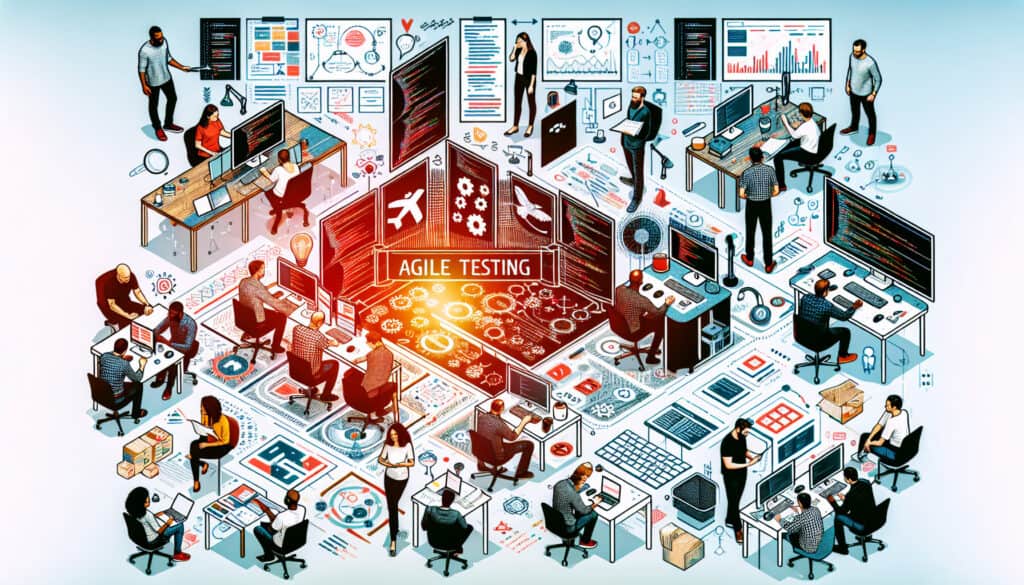A software Práctica de pruebas que sigue los principios del desarrollo ágil de software.
- Metodologías: Clientes y marketing, Ideación, Diseño de producto
Pruebas ágiles

Pruebas ágiles
- Metodología ágil, Desarrollo ágil de productos, Mejora continua, Seguro de calidad, Control de calidad, Gestión de calidad, Melé, Pruebas de software, Métodos de ensayo
Objetivo:
Cómo se utiliza:
- En las pruebas ágiles, las pruebas no son una fase separada, sino que están integradas en el proceso de desarrollo. Los evaluadores colaboran estrechamente con los desarrolladores para garantizar que la calidad se incorpora al producto desde el principio.
Ventajas
- Mejora la calidad del software, reduce el riesgo de defectos y permite una entrega más rápida del software operativo.
Contras
- Puede ser difícil de implantar en equipos de pruebas tradicionales, requiere una estrecha colaboración entre probadores y desarrolladores y puede no ser adecuado para todo tipo de proyectos.
Categorías:
- Diseño de producto, Gestión de proyectos, Calidad
Ideal para:
- Garantizar la calidad del software en un entorno de desarrollo ágil.
El Agile Testing es especialmente beneficioso en sectores en los que los rápidos cambios en los requisitos exigen una mayor adaptabilidad, como el desarrollo de software, el comercio electrónico, los servicios financieros y la sanidad. En estos sectores, el Agile Testing es compatible con las prácticas de integración continua y despliegue continuo (CI/CD), lo que garantiza que las pruebas se realicen simultáneamente con el desarrollo. Durante las iteraciones o sprints, los equipos multifuncionales, incluidos desarrolladores, probadores y propietarios de productos, participan en sesiones de colaboración como la planificación de sprints y las reuniones diarias, lo que facilita la retroalimentación oportuna y las mejoras iterativas. Las metodologías de pruebas ágiles abarcan varias técnicas de prueba, como las pruebas unitarias, las pruebas de integración y las pruebas de aceptación del usuario, que permiten a los equipos detectar los defectos en una fase temprana, cuando su corrección es menos costosa. Este enfoque iterativo minimiza el riesgo de fallos importantes en la producción, mejora la colaboración en equipo y fomenta una cultura de responsabilidad. Herramientas como los marcos de pruebas automatizadas y las plataformas de pruebas continuas se emplean habitualmente para mejorar la eficiencia y proporcionar rápidos circuitos de retroalimentación. Los participantes típicos en este proceso no sólo son los probadores y los desarrolladores, sino también las partes interesadas, como los gestores de productos y los analistas empresariales, que contribuyen a definir los criterios de aceptación y garantizan la alineación con las necesidades del usuario. En contextos en los que la experiencia del usuario es primordial, como el desarrollo de aplicaciones móviles, las pruebas ágiles ayudan a garantizar que las características no solo son funcionales, sino también fáciles de usar, y que cumplen las especificaciones de diseño previstas antes de su lanzamiento.
Pasos clave de esta metodología
- Definir los criterios de aceptación en colaboración con las partes interesadas.
- Implicar a los probadores en la planificación de los sprints para comprender las historias de los usuarios.
- Desarrollar pruebas automatizadas junto con el código de la aplicación.
- Ejecute pruebas continuamente durante el proceso de desarrollo.
- Integrar las pruebas en el proceso de integración y despliegue continuos.
- Realice pruebas exploratorias durante las iteraciones para obtener información inmediata.
- Realice revisiones periódicas del código que incluyan consideraciones relativas a las pruebas.
- Revisar y adaptar las estrategias de pruebas durante las retrospectivas.
Consejos profesionales
- Implementar el desarrollo basado en el comportamiento (BDD) para crear un entendimiento compartido entre los miembros del equipo, mejorando la colaboración entre probadores y desarrolladores.
- Utilizar marcos de pruebas automatizadas al principio del sprint para permitir la integración continua y rápidos bucles de retroalimentación sobre los cambios de código.
- Incorpore sesiones de pruebas exploratorias junto con pruebas programadas para descubrir casos extremos y mejorar la solidez general del producto.
Leer y comparar varias metodologías, recomendamos el
> Amplio repositorio de metodologías <
junto con otras más de 400 metodologías.
Sus comentarios sobre esta metodología o información adicional son bienvenidos en la dirección sección de comentarios ↓ , así como cualquier idea o enlace relacionado con la ingeniería.
Contexto histórico
1828
1850
1854
1854
1911
1928
1950
1827
1848
1850
1854
1895
1914
1943
1970
(si se desconoce la fecha o no es relevante, por ejemplo "mecánica de fluidos", se ofrece una estimación redondeada de su notable aparición)















Publicaciones relacionadas
Gestión de operaciones de fabricación (MOM)
Sistema de Ejecución de Fabricación (MES)
Plan de control de la fabricación
Pruebas manuales
Tablas de evaluación de la manipulación manual (MAC)
ManTRA (Herramienta de evaluación de riesgos en las tareas manuales)